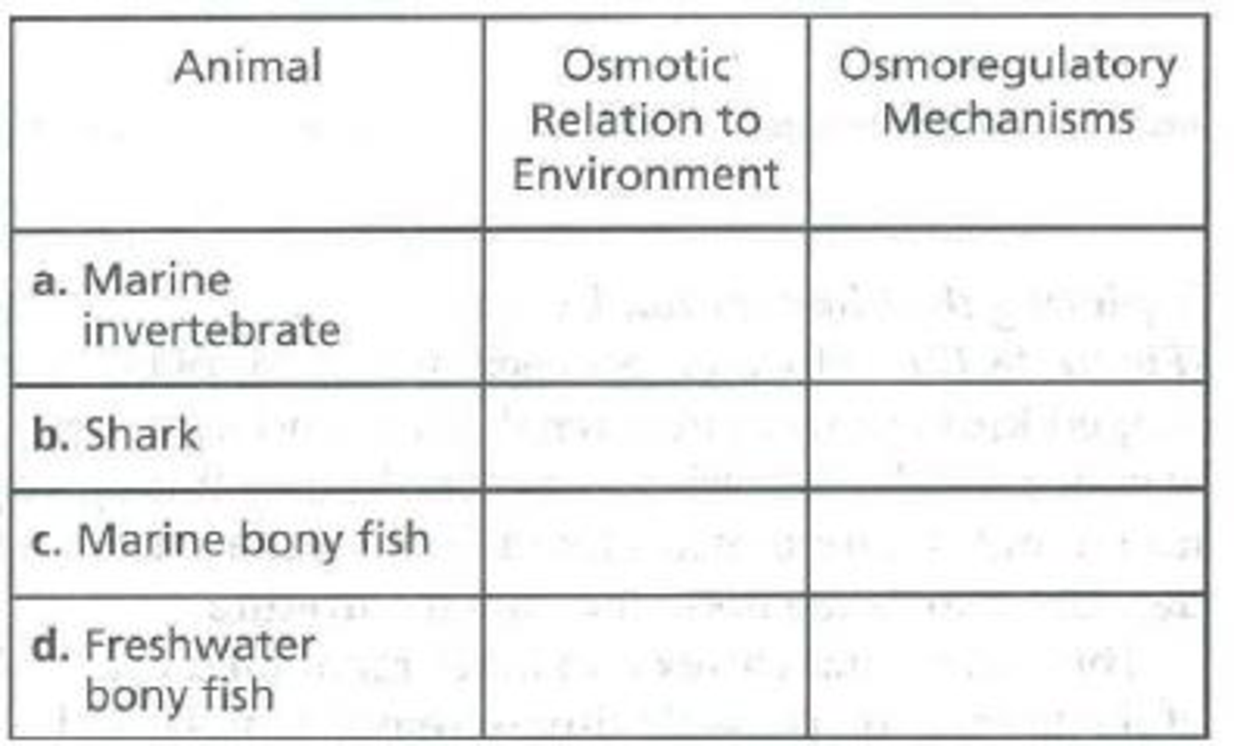
Indicate whether the following animals are isoosmotic, hyperosmotic, or hypoosmotic to their environment and identify their osmoregulatory mechanisms.

To determine: Whether the following animals are isosmotic, hyperosmotic, or hypoosmotic to their environment and to identify their osmoregulatory mechanisms.
Introduction: The maintenance of osmotic pressure within the body is known as osmoregulation. Changes in osmotic pressure are usually sensed by the osmoreceptors that influence the downstream signaling pathways to maintain the homeostasis. Based on its osmotic regulation process the organism is classified into two types namely osmoregulators and osmoconformers. Osmoregulators concentrates and maintains the internal osmotic pressure whereas the osmoconformers involve in the matching of its body osmotic pressure to the environmental osmotic pressure.
Explanation of Solution
| Animal | Osmotic relation to environment | Osmoregulatory mechanism |
| a. Marine invertebrate. | Isosmotic: This organism has an internal environment with the same osmotic pressure that is found in the external environment. | Marine invertebrate is the osmoconformers. Though they have the same osmotic pressure to that of environment this organism regulates the specific solutes for its biological functions. Examples are starfish, mussels, lobsters, and jellyfish. |
| b. Shark. | Slightly hyperosmotic: The shark has slightly higher osmotic pressure than that of its external environment. It has more salinity in the body than in the ocean. | Shark regulates the osmotic pressure by maintaining high amounts of urea and trimethylamine oxide (TMAO) in the body. The excess salts are excreted through kidney and in feces. |
| c. Marine bony fish | Hypoosmotic: The marine bony fish has less osmotic pressure when compared to its external environment. | This organism has the tendency to lose water through gills since it is hypoosmotic to the environment. However, it is compensated by drinking of seawater to maintain the osmotic pressure. Excess salt in the body is excreted through gills. This organism excretes less amount of urine. |
| d. Freshwater bony fish. | Hyperosmotic: The freshwater bony fish has higher osmotic pressure in its internal environment when compared to its external environment. | Due to the hypoosmotic condition in the external environment, there is more loss of salt from the body. Thus it maintains the osmotic pressure by preventing the loss of salt and intake of water. Therefore it produces more amount of dilute urine and it intakes the salt through gills. |
Want to see more full solutions like this?
Chapter 44 Solutions
Biology - Study Guide
- Describe one adaptation for osmoregulation in freshwater animals, saltwater animals, and saltwater plants.arrow_forwarddefine the term osmoregulation and why would it be important for living things to be able to osmoregulate their bodies?arrow_forwardWhat types of osmoregulatory challenges do humans experience? Explain. What mechanisms do we have to meet these challenges?arrow_forward
- The mammalian kidney contains an immense network of nephrons that functions to conserve water by producing urine that is hyperosmotic compared to other body fluids. Explain how the transport epithelia of the nephron and collecting duct are able to use transport mechanisms to process the filtrate as it moves through the vessels and produce a hyperosmotic filtrate.arrow_forwardHypovolemia and circulatory failure in DKA and HHNKS can be attributed to which factors? Question 75 options: Hyperinsulinemia and renal impairment Hyperglycemia and osmotic diuresis Infection and counterregulatory hormones Metabolic acidosis and CNS depressionarrow_forwardBriefly describe how differences in the selective permeability of the different nephron tubules controls solute concentrations.arrow_forward
- Explain the process of thermoregulation in the following: Elephants: Emperor Penguinsarrow_forwardThe mammalian kidney contains an immense network of nephrons that functions to conserve water by producing urine that is hyperosmotic compared to other body fluids. Describe in detail how the transport epithelia of the nephron and collecting duct are able to use transport mechanisms to process the filtrate as it moves through the vessels and produce a hyperosmotic filtrate.arrow_forwardDistinguish the terms in the following pairs: osmotic conformity and osmotic regulation; stenohaline and euryhaline; hyperosmotic and hypoosmotic.arrow_forward
 Human Biology (MindTap Course List)BiologyISBN:9781305112100Author:Cecie Starr, Beverly McMillanPublisher:Cengage Learning
Human Biology (MindTap Course List)BiologyISBN:9781305112100Author:Cecie Starr, Beverly McMillanPublisher:Cengage Learning
